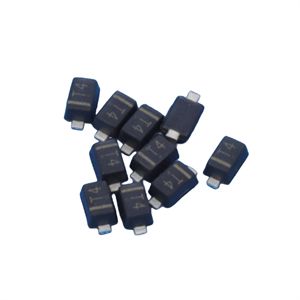Date:2024-10-09 Categories:Product knowledge Hits:275 From:Guangdong Youfeng Microelectronics Co., Ltd
Identification and judgment of voltage regulator diodes
What are the ways to identify and judge voltage regulator diodes in electronic circuits?
1. Identification of Zener diodes in circuits: Zener diodes are commonly represented by "ZD" followed by a number in circuits, for example, ZD1 represents the Zener diode numbered 1.
2. Identification of the positive and negative poles of a voltage regulator diode. From the appearance, the positive end of the metal encapsulated voltage regulator diode body is flat, and the negative end is semi-circular. The colored marked end on the body of the plastic sealed voltage regulator diode is the negative electrode, and the other end is the positive electrode. For voltage regulator diodes with unclear markings, a multimeter can also be used to determine their polarity. The measurement method is the same as for ordinary diodes, that is, using the R × 1k range of the multimeter, connecting the two probes to the two electrodes of the voltage regulator diode, measuring a result, and then adjusting the two probes for measurement. In the two measurement results, the one with the smaller resistance value had the black probe connected to the positive terminal of the voltage regulator diode and the red probe connected to the negative terminal of the voltage regulator diode.
3. Identification of Zener Diodes Color Ring Zener Diode Identification
There are very few domestic products for color ring voltage regulators, and most of them come from abroad, especially Japanese products. Generally, the color ring voltage regulator diode is labeled with the model and parameters, and detailed information can be found in the component manual. The color ring voltage regulator diode has a small volume, low power, and a voltage regulation value mostly within 10V, making it highly susceptible to breakdown and damage. The appearance of a color ring voltage regulator diode is very similar to that of a color ring resistor, so it is easy to make mistakes. The color ring on the color ring voltage regulator diode represents two meanings: one is to represent numbers, and the other is to represent the number of decimal places (usually the color ring voltage regulator diode takes one decimal place and is represented by brown. It can also be understood as a multiplication factor of x 10 (-1 power), and the specific color corresponds to the same number as the color ring resistor).
4. Identification of voltage regulator diode - Difference between voltage regulator diode and ordinary rectifier diode.
Firstly, use the multimeter R × 1K gear to determine the positive and negative electrodes of the tested diode. Then turn the multimeter to the R × 10K position, with the black probe connected to the negative terminal of the tested diode and the red probe connected to the positive terminal of the tested diode. If the measured reverse resistance value is much smaller than that measured in the R × 1K position, it indicates that the tested diode is a voltage regulator; On the contrary, if the measured reverse resistance value is still high, it indicates that the diode is a rectifier diode or a detector diode. The reason for this identification method is that the battery voltage used inside the R × 1K range of the multimeter is 1.5V, which generally does not reverse the breakdown of the tested diode, resulting in a relatively large measured resistance value. When measuring in the R × 10K gear, the voltage of the internal battery of the multimeter is generally above 9V. When the measured diode is a voltage regulator, if the voltage regulator value is lower than the battery voltage value, it will be reverse broken down, greatly reducing the measured resistance value. But if the tested diode is a general rectifier or detector diode, whether measured in R × 1K mode or R × 10K mode, the resulting resistance value will not differ significantly. Note that when the voltage regulation value of the tested voltage regulator diode is higher than the voltage value of the multimeter's R × 10K range, this method cannot be used for differentiation and identification.

Previous: Classification, Structure, and Principle of MOSFET
Next: Using voltage inspection method to quickly locate fault points in integrated circuits